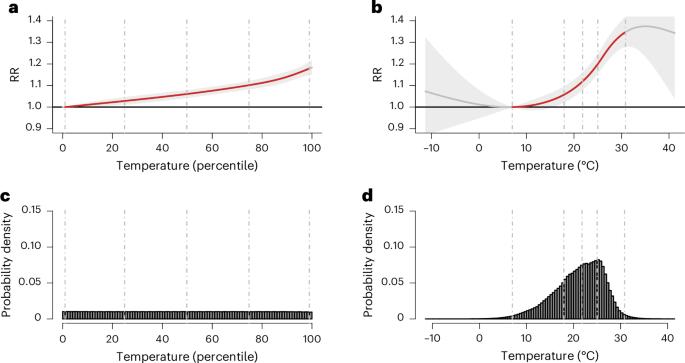Individual and city-level variations in heat-related road traffic deaths in Latin America
引用次数: 0
Abstract
Latin America experiences both high road traffic mortality and extreme heat, which have been shown elsewhere to be interrelated. However, few studies have examined this association in Latin America—one of the world’s most urbanized, fastest-motorizing regions, with a high share of vulnerable road users—and even fewer have analyzed multiple cities across diverse climates and urban settings. Leveraging ambient temperature and road traffic mortality data (2000–2019) from 272 cities in six Latin American countries, we conducted a time-stratified case-crossover study. On the basis of over 1.9 million city-days of data, we found that road traffic mortality risk generally increased with temperature in a monotonic pattern, with significantly elevated risk on extremely hot days, defined at the 95th and 99th temperature percentiles. Risks were particularly high among younger individuals (≤19 years), males, motorcyclists and bicyclists and in cities with hotter climates, longer commutes and more extended street segments. Cities in the tropical Global South should prioritize protecting vulnerable road users, particularly those in peripheral areas, where many endure long, heat-exposed commutes in informal, non-climate-controlled transport. Extreme heat in Latin America increases road traffic mortality risks, with motorcyclists and bicyclists facing a 27% higher risk on the hottest days. Urban protection measures for vulnerable commuters in cities in the Global South are critical as climate change intensifies heat exposure.

拉丁美洲与高温有关的道路交通死亡的个人和城市差异
拉丁美洲经历了高道路交通死亡率和极端高温,而在其他地方,这两者已被证明是相互关联的。然而,很少有研究在拉丁美洲(世界上城市化程度最高、机动化速度最快的地区之一,弱势道路使用者的比例很高)考察这种关联,而分析不同气候和城市环境下的多个城市的研究就更少了。利用来自六个拉丁美洲国家272个城市的环境温度和道路交通死亡率数据(2000-2019年),我们进行了一项时间分层的病例交叉研究。基于超过190万个城市日的数据,我们发现道路交通死亡风险总体上随温度呈单调模式增加,在极热的天气(定义为95和99个温度百分位数)风险显著升高。在年轻人(≤19岁)、男性、摩托车手和骑自行车者以及气候较热、通勤时间较长和街道段较长的城市中,风险尤其高。全球南方热带地区的城市应优先保护脆弱的道路使用者,特别是边缘地区的道路使用者,那里的许多人在非正式的、不受气候控制的交通工具中忍受长时间的高温通勤。拉丁美洲的极端高温增加了道路交通死亡风险,骑摩托车和骑自行车的人在最热的日子里面临27%的风险。由于气候变化加剧了热暴露,对全球南方城市中脆弱的通勤者采取城市保护措施至关重要。
本文章由计算机程序翻译,如有差异,请以英文原文为准。
求助全文
约1分钟内获得全文
求助全文

 求助内容:
求助内容: 应助结果提醒方式:
应助结果提醒方式:


